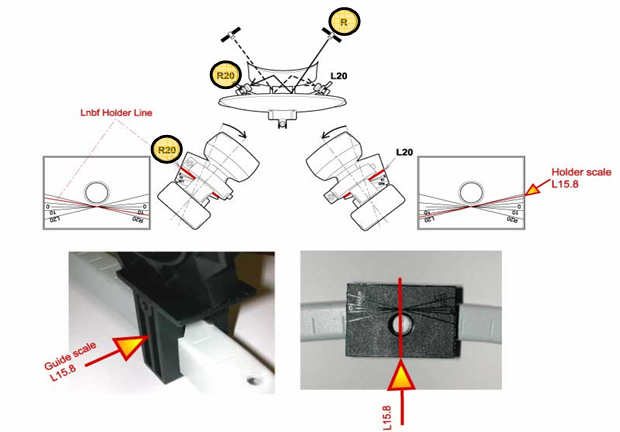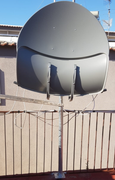Do per scontato che l'elevazione sia già corretta. Rimane da verificare l'inlinazione laterale.
Nella procedura di messa a punto che avrei voluto avviare con Giacomo78, avrei controllato sia lo “skew” della staffa che l'elevazione della parabola, in quanto l'angolo di elevazione ottimale per una configurazione multifeed può essere messo a punto solo quando lo “skew” della staffa è stato messo a punto prima.
Quindi penso che sia corretto concludere che l'elevazione della parabola è “circa” buona, quando lo “skew” della staffa/piatto non è ancora stato controllato e messo a punto.
Nella mia procedura ho iniziato chiedendo di controllare e impostare l'angolo di “skew” per una ricezione ottimale di 42E.
Successivamente avrei chiesto di verificare se l'altro estremo, 1,9E, fosse già perfetto o se fosse necessaria una rotazione/spostamento “skew” un po' più alta o un po' più bassa.
L'angolo di inclinazione migliore per la parabola sarebbe quindi a metà strada tra l'impostazione ottimale di “skew” per 42E e l'impostazione ottimale di “skew” per 1,9E.
Una modifica dell'angolo di “skew” avrebbe comportato, tuttavia, che l'elevazione attuale per i due satelliti estremi non fosse perfetta e dovesse essere anch'essa messa a punto.
(Con un multifeedrail fisso, è consuetudine scegliere l'elevazione migliore per i due satelliti estremi, anziché quella per il satellite centrale, poiché di solito sono più deboli di quest'ultimo).
Anche se si tratta di piccole variazioni di angoli, esse sono importanti per le circostanze di ricezione difficili.
(A proposito: Con questa procedura, non importa quale sia la posizione del satellite “centrale”. La procedura di messa a punto viene eseguita sulla base dei satelliti estremi, non su quella del satellite centrale).
Dopodiché, ovviamente, la direzione dello sguardo, la posizione sulla staffa/rotaia, il posizionamento vicino/lontano e lo “skew” individuale dei singoli LNB sarebbero stati all'ordine del giorno.
Ma Giacomo78 sembra essere pieno di altri piani; non di seguire la mia procedura, con il T90. Quindi non vedo una procedura del genere nel prossimo futuro.
Tradotto da:
In the fine-tune procedure that I had wanted to start with Giacomo78, I would have checked both the rail "skew" and the dish elevation, as the optimal elevation angle for a multifeed setup can only be fine-tuned when the rail "skew" has been finetuned before that.
So I think it is only correct to conclude that the dish elevation is "about" good, when the rail/dish "skew" is not checked and finetuned yet.
I started off in my procedure with asking to check and set the "skew" angle setting for optimal reception of 42E.
After that I would have asked checking if the other extreme, 1.9E, was already perfect, or needed a "skew" rotation/displacement a bit higher, or a bit lower.
Best skew angle for the dish then would be halfway between optimal "skew" setting for 42E, and optimal "skew" setting for 1.9E.
A changed "skew" angle would then have meant, however, that the present elevation for the two extreme satellites was not perfect, and had to be finetuned as well.
(With a fixed multifeedrail, it is customary to choose the best elevation for the two extreme satellites, instead of the best elevation for the central satellite; as they are usually weaker than the central satellite.)
Though it might be about small changes in angles, they are important, for difficult reception circumstances.
(By the way: So with this procedure, it does not matter what is in fact the "central" satellite position. The finetuning procedure is done on the base of the extreme satellites, not on the base of the central satellite.)
After that, of course looking direction, position on the rail, near/far positioning and individual "skew" of the individual LNBs would have been on the agenda.
But Giacomo78 seems to be full of other plans; not full of following my procedure, with the T90. So I don't see a procedure like this happening, in the near future.
Ciao,
A33.







